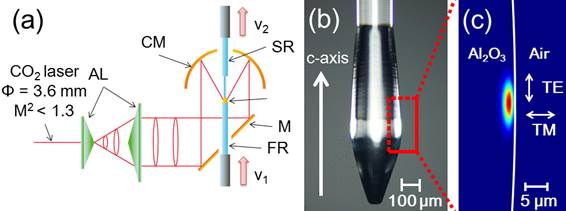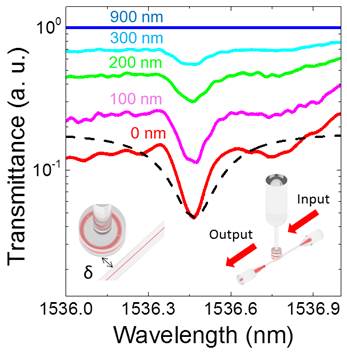Fabrication of micro optical resonators using crystal growth technology
Research
Fabrication of micro optical resonators using crystal growth technology
Toward Ultimate Optical Confinement
In the Tanabe Laboratory, micro optical resonators are fabricated using crystal growth techniques. Although silicon and silica have been used to fabricate resonators in the past, dielectric crystal materials have attracted much attention in recent years. This is because micro optical resonators made of crystalline materials can realize modulation using electro-optic effects and high-performance optical confinement, and are expected to contribute to the improvement of efficiency of optical signal processing and the development of quantum information processing research. In this study, we fabricated micro optical resonators using a crystal growth technique called laser heated pedestal growth (LHPG).
The LHPG method was developed to fabricate fiber lasers, and the key point of the technique has been how to fabricate crystal rods with smooth and uniform diameters. However, by changing the pulling speed of the crystals, we have succeeded in fabricating a rod with a diameter that changes only in a part of the rod, thereby confining the light. This is the first attempt in the world to fabricate micro optical resonators by the LHPG method. (Figure 1)
In this study, we fabricated a high-performance micro optical resonator with a Q-value of 1.6×104, which represents the light confinement performance, using sapphire (Figure 2). We are planning to further improve the performance by reducing the mode volume and surface roughness.
Part of this research was sponsored by the Strategic Information and Communications R&D Promotion Program (SCOPE). In addition, this research was financially supported by Grant-in-Aid for Scientific Research and Technology (2560018) and the Next Generation Research Project Promotion Program of Keio University.

(a) Experimental setup for the LHPG method. AL : Axicon lens, FR : Feed rod, M : Gold mirror, CM : Concave mirror (curvature = 100 mm), SR : Seed rod. (b) Side view of the fabricated resonator. The diameter is 240 um. (c) Profile of TM mode using finite element method. The mode volume is Veff = 1.28×10-2 cm3.

Variation of output spectrum with distance between tapered fiber and resonance period. Q = 1.6×104 was obtained at contact. The inset shows the experimental setup for optical measurements with a tapered fiber.
- Categories
- 研究トピックス



